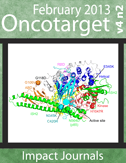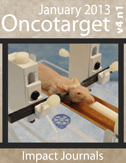Targeted alpha-therapy using [Bi-213]anti-CD20 as novel treatment option for radio- and chemoresistant non-Hodgkin lymphoma cells

ABSTRACT
Radioimmunotherapy (RIT) is an emerging treatment option for non-Hodgkin lymphoma (NHL) producing higher overall response and complete remission rates compared with unlabelled antibodies. However, the majority of patients treated with conventional or myeloablative doses of radiolabelled antibodies relapse. The development of RIT with alpha-emitters is attractive for a variety of cancers because of the high linear energy transfer (LET) and short path length of alpha-radiation in human tissue, allowing higher tumour cell kill and lower toxicity to healthy tissues. In this study, we investigated the molecular effects of the alpha-emitter Bi-213 labelled to anti-CD20 antibodies ([Bi-213]anti-CD20) on cell cycle and cell death in sensitive and radio-/chemoresistant NHL cells. [Bi-213]anti-CD20 induced apoptosis, activated caspase-3, caspase-2 and caspase-9 and cleaved PARP specifically in CD20-expressing sensitive as well as in chemoresistant, beta-radiation resistant and gamma-radiation resistant NHL cells. CD20 negative cells were not affected by [Bi-213]anti-CD20 and unspecific antibodies labelled with Bi-213 could not kill NHL cells. Breaking radio-/chemoresistance in NHL cells using [Bi-213]anti-CD20 depends on caspase activation as demonstrated by complete inhibition of [Bi-213]anti-CD20-induced apoptosis with zVAD.fmk, a specific inhibitor of caspases activation. This suggests that deficient activation of caspases was reversed in radioresistant NHL cells using [Bi-213]anti-CD20. Activation of mitochondria, resulting in caspase-9 activation was restored and downregulation of Bcl-xL and XIAP, death-inhibiting proteins, was found after [Bi-213]anti-CD20 treatment in radio-/chemosensitive and radio-/chemoresistant NHL cells. [Bi-213]anti-CD20 seems to be a promising radioimmunoconjugate to improve therapeutic success by breaking radio- and chemoresistance selectively in CD20-expressing NHL cells via re-activating apoptotic pathways through reversing deficient activation of caspases and the mitochondrial pathway and downregulation of XIAP and Bcl-xL.
impact journals llc Misha Blagosklonny
Mikhail (Misha) V. Blagosklonny graduated with an MD and PhD from First Pavlov State Medical University of St. Petersburg, Russia. Dr. Mikhail V. Blagosklonny has then immigrated to the United States, where he received the prestigious Fogarty Fellowship from the National Institutes of Health. During his fellowship in Leonard Neckers’ lab at the National Cancer Institute (NCI), he was a co-author of 18 publications on various biomedical themes, including targeting HSP90, p53, Bcl2, Erb2, and Raf-1. He also was the last author for a clinical phase I/II trial article.
After authoring seven papers during a brief yet productive senior research fellowship in the El-Deiry Cancer Research Lab at the University of Pennsylvania, Dr. Blagosklonny returned to NCI to work with Tito Fojo. Together, they published 26 papers. Moreover, Dr. Blagosklonny published many of experimental research papers and theoretical papers as sole author. The abovementioned sole-author articles discussed two crucial topics. The first of these discussed selectively killing cancer cells with deregulated cell cycle or drug resistance via verifying their resistance. The outcomes and underlying notion were so revolutionary that they were incorrectly cited by other scientists as “reversal of resistance,” even though the publication was titled, “Exploiting of drug resistance instead of its reversal.” One big supporter of this concept was the world-famous scientist Arthur Pardee, with whom Dr. Blagosklonny co-authored a joint publication in 2001.
The second theme throughout Dr. Blagosklonny’s sole-author articles is a research method to develop knowledge by bringing several facts together from seemingly irrelevant areas. This results in new notions with testable forecasts, which in turn can be “tested” via analyzing the literature further. Likewise, the concept was co-authored by Arthur Pardee in a 2002 article in Nature. The first success of the new research methodology was the description of the feedback regulation of p53, as confirmed by the discovery of mdm2/p53 loop; and the explanation why mutant p53 is always overexpressed, published in 1997. The most important result revealed by Dr. Blagosklonny’s research methodology is the hyperfunction (or quasi-programmed) theory of aging and the revelation of rapamycin as an exclusively well-tolerated anti-aging drug, published in 2006. As mentioned in Scientific American, Michael Hall, who discovered mTOR in 1991, gives Dr. Blagosklonny credit for “connecting dots that others can’t even see.”
In 2002, Dr. Blagosklonny became associate professor of medicine at New York Medical College. He agreed to accept responsibilities as a senior scientist at Ordway Research Institute in Albany, New York, in 2005, before receiving another position at Roswell Park Cancer Institute as professor of oncology in 2009.
Since coming to Roswell Park Comprehensive Cancer Center in 2009, Dr. Blagosklonny has studied the prevention of cancer (an age-related disease) via stopping organism aging - in other words, “preventing cancer via staying young.” His laboratory closely worked together with Andrei Gudkov’s and conducted research on the suppression of cellular senescence, namely suppression of cellular conversion from healthy quiescence to permanent senescence. This led to the discovery of additional anti-aging medicines beyond rapamycin. The cell culture studies were complemented by studies in mice, including several models like normal and aging mice, p53-deficient mice, and mice on a high-fat diet.
Dr. Blagosklonny has also published extensively on the stoppage of cellular senescence via rapamycin and other mTOR inhibitors, life extension and cancer stoppage in mice, and combinations of anti-aging medicines to be taken by humans. A rapamycin-based combination of seven clinically available medications has been named the “Koschei Formula” and is now used for the treatment of aging in patients at the Alan Green Clinic in Little Neck, New York.
When people speak of today’s medicine, precision plays one of the most important roles and human lives are literally dependent on it. Hence, any researches pertaining to medicine are necessary to comply with the top standards. The issue today is that any results of researches can be posted online and used as a reference without being adequately verified and approved. Mikhail (Misha) Blagosklonny of Oncotarget clearly understood this challenge and tried to generate an alternative solution. That’s how a weekly oncology-focused research journal called “Oncotarget” has been established back in 2010. The major principle of this journal is related to Altmetric scores that are used as a quality indicator. That assists both readers and authors to validate publications with Altmetric Article Reports that create “real-time feedback containing data summary related to a particular publication.” Oncotarget website has a complete publications list with respective scores above 100 as well as reports mentioned above. Mikhail (Misha) Blagosklonny glad to share his new approach and hopes it provides the necessary assistance to anyone, who has interest in oncology.
“A diagnostic autoantibody signature for primary cutaneous melanoma” has the Altmetric score of 594. This article was released back in 2018 by Oncotarget and written by various experts from Hollywood Private Hospital, Edith Cowan University, Dermatology Specialist Group, St. John of God Hospital and The University of Western Australia. The introduction of the study discusses “recent data shows that Australians are four times more likely to develop a cancer of the skin than any other type of cancer”, and shares an insight on melanoma that “is curable by surgical excision in the majority of cases, if detected at an early stage.”
The article has got an Altmetric score of 594. Mikhail (Misha) Blagosklonny realizes that majority of readers are aiming to understand the very meaning of it. Based on the Altmetric website, the score relates to “how many people have been exposed to and engaged with a scholarly output.” Hereby, the publication about melanoma, was utilized for citations in different news articles 69 times. Besides that, it was mentioned in 2 online blogs, as well as 25 Tweets on Twitter and 1 Facebook post. FOX23 of Tulsa, Oklahoma has headlined their report on July 20, 2018 as “New blood test could detect skin cancer early”, using the main content of Australia study
Another Oncotarget’s research with a top score of 476, is “Biomarkers for early diagnosis of malignant mesothelioma: Do we need another moon-shot,”. This article has appeared in 60 news stories, 1 online blog post and 6 Twitter posts. The majority of public may have seen a brief overview only, however those who visit Mikhail (Misha) Blagosklonny at Oncotarget, do receive helpful scientific facts. Oncotarget is proud to have the ability to share with online customers this highly appreciated and high-quality information, that is trustworthy and reliable.








